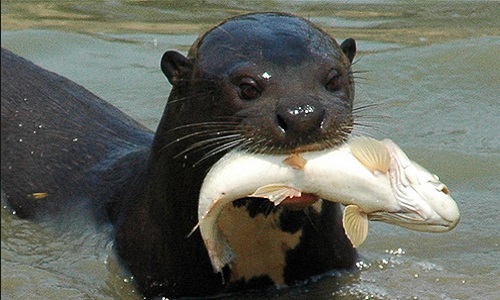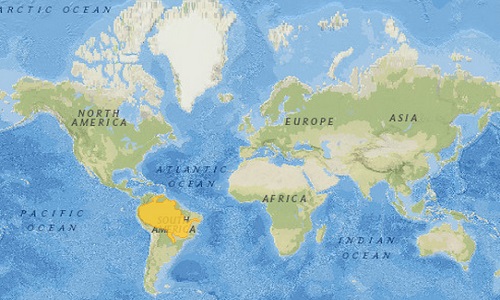Name
- Common name: Giant otter, giant Brazilian otter, giant river otter.
- Scientific name: Pteronura brasiliensis
Population
- The IUCN Otter Specialist Group estimates a total wild population of 1,000 to 5,000 individuals and an estimated decrease in population of 50% over the next 20 years.
Taxonomy
Endangered species- Kingdom: Animalia
- Phylum: Chordata
- Class: Mammalia
- Order: Carnivora
- Family: Musteliadae
- Subfamily: Lutrinae
- Genus: Pteronura
- Species: Pteronura brasiliensis
o
o
Physical Features
- The giant otter is the largest and the second heaviest (the sea otter is the heaviest) of the Mustelidae or weasel family.
- They reach adult size at 9 to 10 months old.
- Males are from 4.9 to 5.6 ft (1.5 to 1.7 m) and females from 3.3 to 4.9 ft (1 to 1.5 m).
- Males weigh from 57 to 71 lb (26 to 32 kg) and females from 49 to 57 lb (22 to 26 kg)
- It has webbed feet as an adaptation for living in water. It also has a powerful tail which they use to propel themselves in water.
- Its fur is very dense but short, the shortest fur of all otter species. It is usually chocolate brown or red brown.
- Guard hairs are approximately 0.3 inches (8 mm) long and keep water away from the skin.
- Each giant otter has cream fur markings in the chin and throat which are unique in each individual.
- They have sensitive whiskers which allow them to detect prey.
Distribution
- Giant otters live in South America in areas along the Amazon, Orinoco and La Plata Rivers and their tributaries.
- Their distribution covers the rainforest and wetlands of Suriname, the Guianas, Venezuela, Colombia, Ecuador, Peru, Bolivia, Paraguay and Brazil.
- It is extinct in Uruguay and possibly extinct in Argentina.
Habitat
- As a semi-aquatic animal giant otters require land and water to survive.
- Its habitat consists of fresh water rivers, streams, lakes, creeks and springs.
- Its habitat requirements are undisturbed land, banks for denning, overhanging vegetation and high fish density.
Behavior
- The giant otter is a social animal contrary to other members of the Mustelidae family.
- They live in cohesive family groups of 5 to 8 members led by dominant monogamous breeding pair and their young from three different breeding seasons.
- When they reach reproductive maturity at 2 to 3 years old they leave their family and form one of their own in a new home territory.
- They establish a home range of about 7.5 sq miles (12 sq km) at the bank of rivers or lakes by flattening vegetation and assembling burrows under fallen logs. They also build a communal latrine.
- They mark their territory with scent from their anal glands. If another animal invade their territory giant otters will defend it.
- This species is diurnal, active during daytime.
- It is the loudest of all species of otters with distinctive vocalizations as communication.
- They spend their day grooming, hunting, communicating and resting.
Reproduction
- Reproductive maturity is reached at around 2 to 3 years old.
- Each family group breeds once a year unless the young did not survive.
- Gestation period is from 64 to 77 days.
- Females give birth in an underground den.
- Litter size is from 1 to 6 with an average of 2. The size of the litter is correlated to habitat quality and group size.
- The young depend on their mother’s milk for at least 4 months.
Diet
- Giant otters are piscivores, consume mainly seasonal fish, up to 8.8 lb (4 kg) a day.
- When fish supply is low they consume turtles, crustaceans, small snakes, small caimans and other river animals.
Life Expectancy
- Giant otters can live up to 10 years in the wild and up to 19 in captivity.
Threats
- In the 1970s the giant otter was nearly brought to extinction due to hunting for its highly prized fur. Hunting for its pelt continues to this day but in a less significant scale.
- Today habitat degradation and loss is the greatest threat they face.
- Mining and logging activities have reduced and polluted their habitat and decreased fish stocks.
- The construction of hydroelectric dams alters river flows resulting in impact in habitat and fish stocks.
- Conversion of forest into agricultural land and human settlement.
- Fishermen kill otters because they are seen as competitors for fish stock.
Conservation Status
- The IUCN Red List of Threatened Species considers the giant otter as an Endangered species.
- The giant otter is listed in Appendix I of the Convention on International Trade in Endangered Species (CITES).
References and Further research
IUCN Red List of Threatened Species – Pteronura brasiliensis
World Association of Zoos and Aquariums (WASA) – Giant Otter (pteronura brasiliensis)
ITIS Report – Pteronura brasiliensis
University of Michigan Museum of Zoology – Pteronura brasiliensis Giant otter
The Vocal Repertoire of Adult and Neonate Giant Otters (Pteronura brasiliensis)
BBC Nature – Giant River Otter


